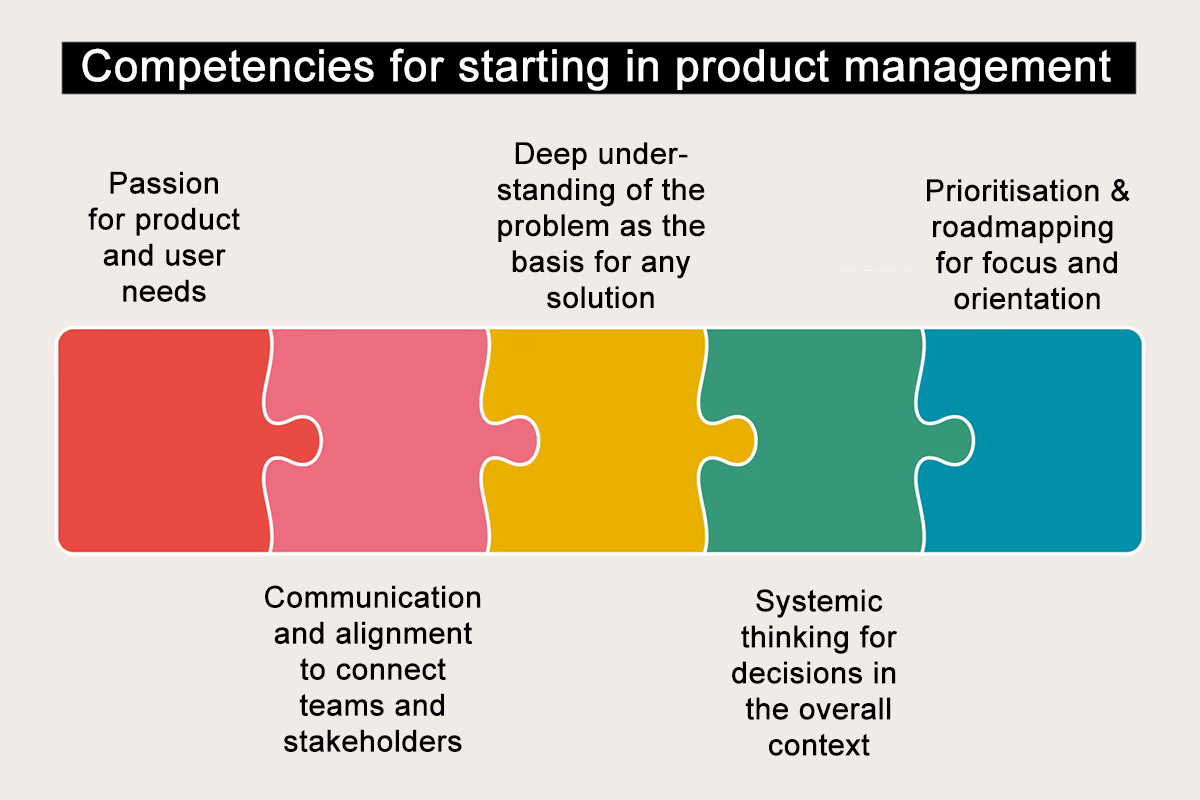A successful start in product management
Expand the table of contents
Passion as the basis for successful product development
Communication and alignment as the key to success
Understanding the problem as the basis for developing solutions
Systemic thinking for an overview in product management
Roadmaps and prioritisation for orientation and efficiency
Conclusion: How to successfully get started in product management
Practical tip
Entering product management presents career starters with demanding challenges. In addition to data skills, customer insight and the courage to make decisions, curiosity, structure and the ability to connect people are also required. Modern product management also requires strategic thinking, operational action and strong communication skills, as well as an overview of the company’s entire business model. For those who underestimate these requirements, entering product management can be risky.
This article highlights the skills, mindsets and approaches that are particularly crucial for junior product managers today in order to make an early impact in the company and achieve long-term success. These recommendations significantly reduce the risk of a false start in product management.
Mastering the start: obstacles, expectations and initial successes
Starting a career in product management is challenging because theory and practice are often far apart. On the one hand, there is a lack of experience in dealing with real market and user data, and on the other hand, employers’ expectations are high. Many companies are looking for young professionals who can think analytically, communicate confidently, negotiate and work across departments.
The first few months in particular determine whether a junior product manager will build trust in the company or their department in the long term. Those who network early on, actively ask questions and regularly seek feedback quickly learn how decisions are made in the company.
Regular practical experience is the key here. Career starters who have already had experience with customers, markets or product development during internships or working student positions usually start the role with more confidence.
Passion as the basis for successful product development
Passion is more than just motivation. It is the driving force behind understanding your own product or service down to the last detail, taking responsibility and taking the needs of users seriously. In product management, it determines whether you simply administer or actively take on the role of designer.
A common mistake is to focus on tables and tools without experiencing the actual benefits of the product. Numbers are important, but they only tell part of the story. Passion always arises when data is combined with a genuine understanding of users.
In practice, there are five proven ways to build proximity to the product:
- Actively use the product yourself to experience its strengths and weaknesses first-hand. It is not enough to have read the user manual.
- Conduct small experiments and MVPs [1] to generate your own learning progress.
- Hold regular user discussions to develop empathy and identify needs.
- Observe and analyse competing products to get to know your own product better and position it more effectively. Comprehensive benchmarking is a great way to do this.
- Make successes visible using clear metrics such as customer satisfaction or adoption.
Passion does not arise by chance, but through conscious action, observation and iteration.
Communication and alignment as the key to success
As in all areas of business, the same applies to product management: successful product work can only be achieved if everyone involved is working towards the same goal. Communication is the most important tool for connecting teams, customers and management. Clear coordination prevents misunderstandings, friction losses and inefficient processes.
Many juniors underestimate how important it is to actively seek dialogue from the outset. Only those who regularly talk to sales, development or marketing recognise connections earlier and avoid misunderstandings. Stakeholder alignment [2] is a key concept here, not least because visibility is created not by volume but by clarity.
There are three basic principles for effective communication:
- Formulate expectations clearly and justify them transparently to build trust.
- Explain decisions in a comprehensible manner, as people follow logic rather than hierarchy.
- Visualise complex topics to make content understandable and tangible. This is particularly helpful in the beginning to be taken seriously as a junior product manager.
Good product managers are rarely the loudest, but almost always the clearest. Those who listen, make connections visible and bring teams together quickly become indispensable.
Understanding the problem as the basis for developing solutions
One thing is certain from the history of product management: successful product work does not begin with a solution, but with understanding the problem. Anyone who develops features without understanding the underlying user needs risks optimising in the wrong areas.
Data analyses, user interviews and market observations provide clues as to what customers actually need. Junior product managers are advised to take the time from the outset to identify patterns, test hypotheses and systematically analyse causes.
There are various approaches that help to gain a better understanding of the problem:
- Conduct user interviews to identify specific needs. As a junior product manager, you should spend 20-30% of your weekly working time on this!
- Use methods such as ‘5 Whys’ or ‘Jobs to be Done’ to systematically investigate causes.
- Collect empirical data through observation and questioning in a person’s working environment (known as apprenticing).
Understanding problems saves resources and enables the creation of targeted solutions that offer sustainable added value.
Systemic thinking for an overview in product management
Product management is never one-dimensional. It is far too multifaceted and complex for that. Every decision has an impact on technology, processes, sales and strategy. Systemic thinking means recognising connections and evaluating decisions in the overall picture.
Experience reports show that junior product managers tend to apply methods in isolation. But it is the combination of different approaches that makes product work effective. Only then can the significant impact of a perhaps small decision be understood.
If you want to develop systemic thinking, you can use the following checklist:
- Analyse dependencies between technical, organisational and economic factors. Simple graphical illustrations of dependencies can help to understand interactions.
- Understand team dynamics in order to take roles, competencies and influences into account.
- Understand the business model in order to recognise the effects of decisions on value creation and turnover.
- Combine methods in a targeted manner in order to optimally coordinate processes and decisions.
Those who consistently follow these steps will lay the foundation for a good overview of product management and make informed decisions even in complex business environments.
Roadmaps and prioritisation for orientation and efficiency
A roadmap is more than just a plan; it is a tool for creating focus and providing orientation throughout the entire company. It links strategic goals with operational implementation and highlights which measures generate which benefits.
Junior product managers should learn early on to read and understand roadmaps and translate them into concrete steps. Those who understand priorities will more quickly grasp why certain issues are given priority or postponed.
The following approach is recommended for creating an effective roadmap:
- Set priorities consciously and use methods such as RICE or WSJF to justify decisions.
- Combine strategy and implementation, for example with OKR [3] or clear goal hierarchies.
- Communicate decisions transparently so that stakeholders can recognise the reasons for changes.
- Allow for flexibility so that the roadmap can respond to market changes.
A well-structured roadmap provides an overview, strengthens trust and ensures the effective use of resources.
Conclusion: How to successfully get started in product management
Getting started in product management is not a question of tools, and specialist knowledge alone is not enough. It is a question of attitude. Those who ask questions, take responsibility and recognise connections will quickly grow into the role and create visible benefits.
Visibility comes from clear communication, comprehensible results and a professional appearance. Junior product managers should learn to document assumptions, share interim results and justify decisions. This is how they make progress tangible.
In addition, learning is a debt that must be repaid. Those who do not wait for an employer to provide training opportunities, but actively invest in themselves, develop more quickly. Even short training courses on topics such as prioritisation, user interviews or data interpretation can bring noticeable progress. The key is consistent implementation in practice and actively seeking feedback.
In summary, the five key competencies for a successful start in product management are:
- Passion for the product and user needs
- Communication and alignment to connect teams and stakeholders
- Deep understanding of the problem as the basis for any solution
- Systemic thinking for decisions in the overall context
- Prioritisation and roadmapping for focus and orientation
Figure: Competencies for starting in product management
Those who specifically train these skills and apply them in practice will develop from beginners to creative professionals in product management and deliver tangible added value for the company at an early stage.
Practical tip: Tailor your entry into product management
If you want to expand your skills as a junior product manager in a practical way, the German impulse session professional product management – your introduction to strategy, methods and successful product development offers a compact, interactive introduction.
The impulse session provides practical insights and concrete approaches that can be applied immediately. With interactive exercises, best practices and a clear focus on data-based decisions, you will learn how to efficiently develop, market and optimise products.
Notes:
Are you interested in talking to Fabian Puls? Then simply send him a message on LinkedIn or visit his informative website.
[1] What is a MVP?
[2] How does stakeholder alignment work?
[3] What is OKR?
Are you a multiplier or opinion leader who wants to discuss getting started in product management? Then share this post with your network.

Fabian Puls
Fabian Puls is the founder and managing director of Product Impulse UG. He offers interactive live online courses with innovative learning methods that actively involve participants and enable practical learning. His courses focus on key product management topics such as product strategy, market analysis and agile methods, and are held in small groups to promote individual and sustainable learning success.
As a Certified Product Manager (FH) and Professional Scrum Product Owner™, Fabian Puls combines in-depth methodological knowledge with many years of experience in national and international projects.
He also hosts the Küstenimpuls Meetup, where product managers regularly exchange ideas on current topics.
In the t2informatik Blog, we publish articles for people in organisations. For these people, we develop and modernise software. Pragmatic. ✔️ Personal. ✔️ Professional. ✔️ Click here to find out more.
